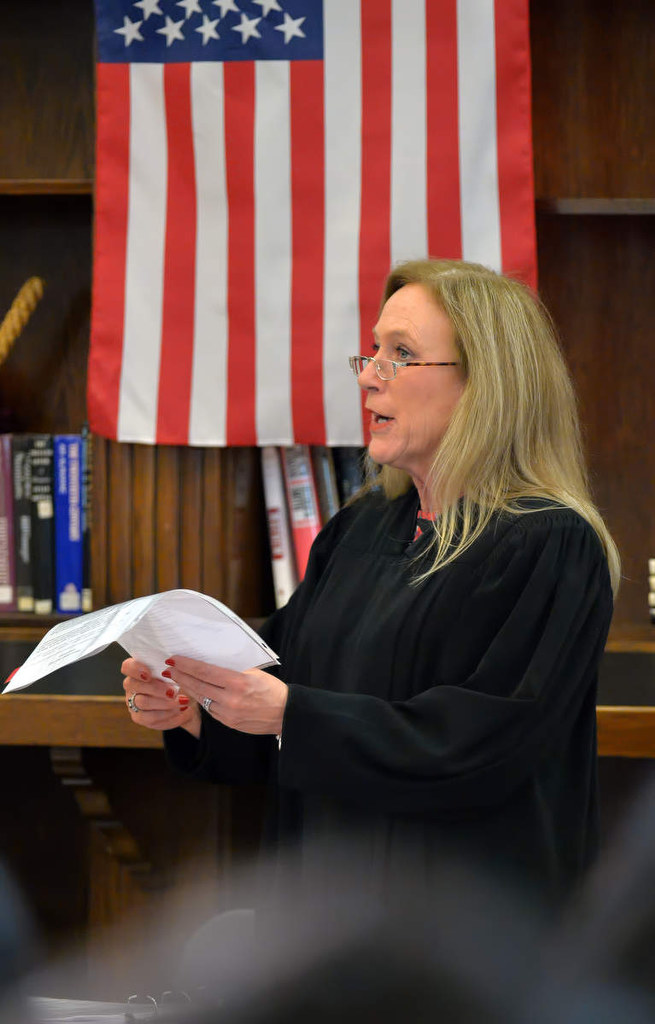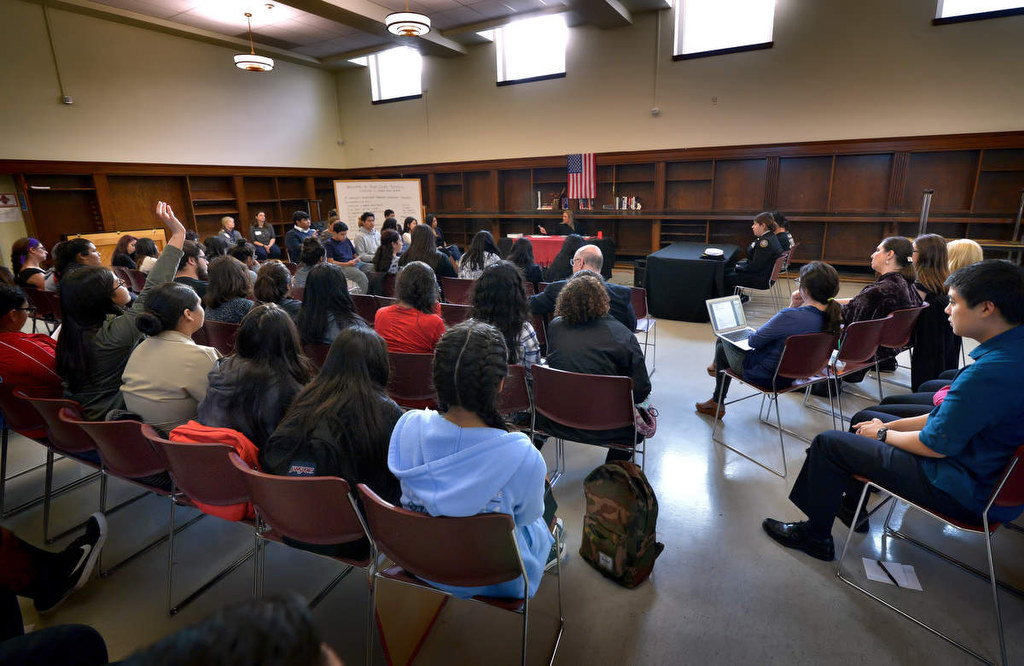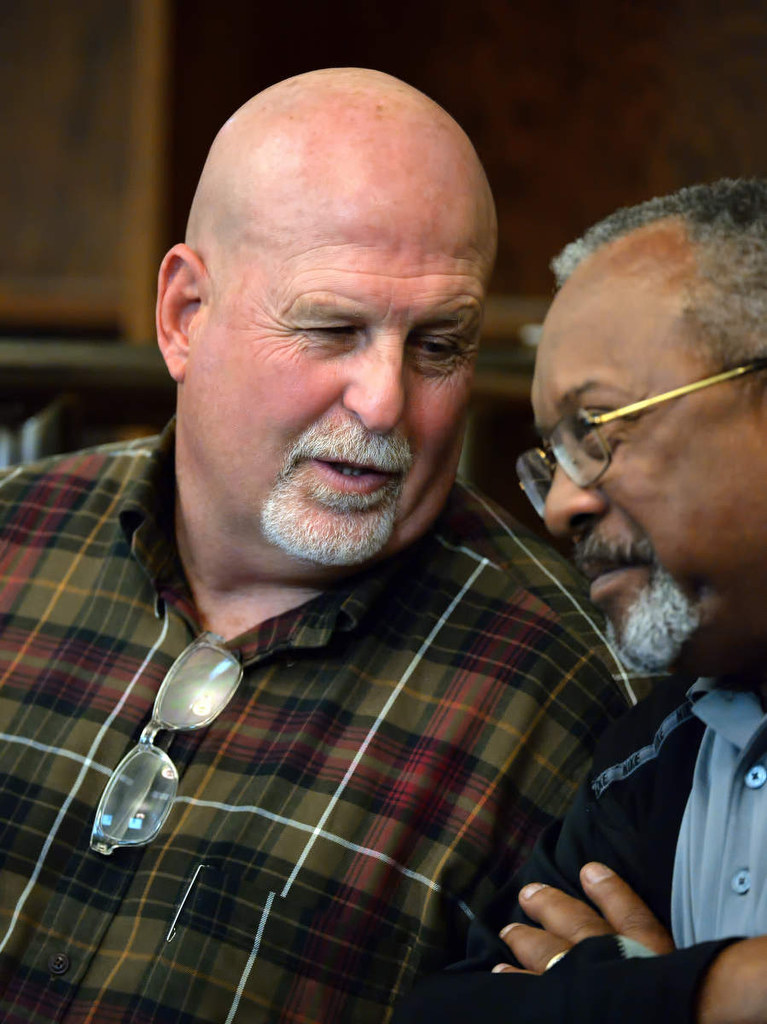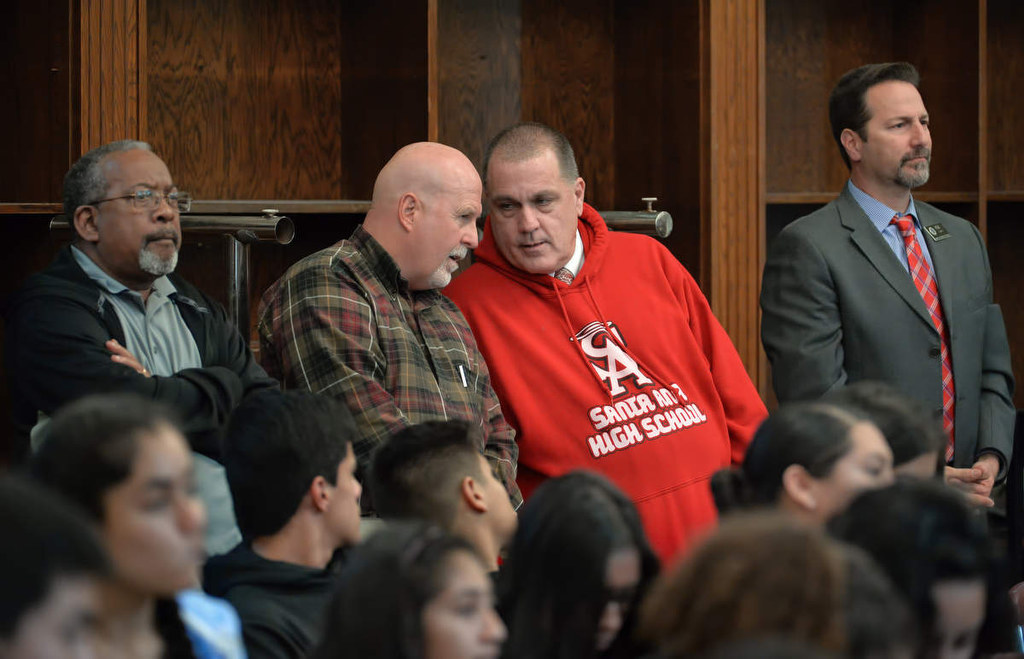It’s after school in the teacher’s lounge at Santa Ana High School but there’s a Superior Court judge wearing black robes sitting at a table draped in red in the front of the room.
A 14-year-old boy wearing a flannel shirt and white kicks is sitting at another table next to his step-dad.
“This is a real court proceeding, did you know that?” Family Court Judge Claudia Silbar asks the audience of about 150 students sitting in folding chairs.
She then picks 10 students from the crowd, five boys and five girls, and tells them to fill two rows of chairs off to the side, facing the boy.

Students attend a Peer Court session held at Santa Ana High School with Judge Claudia Silbar presiding.
Photo by Steven Georges/Behind the Badge OC
The judge swears in the defendant and his step-dad. A probation officer standing by reads the charges.
In a nutshell: The boy got busted with weed in the boys’ room at an Anaheim high school. He said that a stranger gave it to him the night before outside a liquor store. And that he took it to school and his buddy happened to smell it from where it was hidden in his pocket. And when his buddy found out that what he was smelling was weed, he told him they should go in the bathroom and try it.
Judge Silbar tells the boy he is allowed to give a statement.
“I made a bad decision and it was pretty stupid of me to bring marijuana on school grounds and I won’t do it again,” he says.
The step-dad is told he can give a statement, too.
“He’s a good kid,” the step-dad says. “He’s not a bad kid. I just hope that it doesn’t take him too long to get it. Some people get it sooner than others.”
Then the judge tells the student jury to ask away, any question they want.
It’s a tough crowd. The students grill the boy for the next half hour.
Why would you accept marijuana from a stranger? (I don’t know)
You said it was a joint. Did you roll the joint, who rolled the joint? (silence)
How do you do in school? (I’ve been turning in all my work)
Why did you smoke marijuana? (Um, I don’t know.)
Do you have siblings? (Two little sisters)
Would you be happy if they were smoking marijuana at their school? (No)
Did you realize it was against the law for a kid to smoke marijuana? (No)
The judge can’t let that one go.
“Wait wait wait,” she says to the boy. “You’re telling us you did not realize it was against the law to smoke marijuana? Is that true or not true?”
“Not true,” the boy confesses.

Judge Claudia Silbar presides over a session of Peer Court at Santa Ana High School.
Photo by Steven Georges/Behind the Badge OC
“Today’s the day you want to be honest,” the judge continues. “Where do you see yourself in five years?”
“I don’t know,” the boy says.
And that is what this day is all about.
Giving kids one more chance to take a look at where they might end up if they continue breaking the law.
It’s called Peer Court.
Started in 1994, Peer Court is a collaboration between the Orange County Superior Court, Orange County Probation Department, Orange County Department of Education and the non-profit Community Service Programs Inc. The goal: to keep minors with non-violent misdemeanor offenses out of the juvenile court system.
The Constitutional Rights Foundation (CRF) of Orange County, a non-profit organization dedicated to promoting civic literacy and youth leadership, raises money to fund it.
Last year, 14 Orange County schools in Newport Beach, Irvine, Yorba Linda, Rancho Santa Margarita, Anaheim and Santa Ana participated. Twenty-eight cases were presented. And about 1,000 students participated as jurors and audience members.
“Keeping kids in school and out of court,” says Alan Slater, retired clerk of the Orange County Superior Court who is now co-chair of the CRF’s Peer Court Committee. “The focus is on … apologies. Community service. Breaking the prison pipeline. To help them realize they have one foot on the banana peel. That’s a route to nowhere.”
Slater is hoping to expand the program, but more police departments need to sign on.
Currently, only the Anaheim, Fountain Valley, Huntington Beach, Irvine and Laguna Beach police departments participate.

Retired clerk of Orange County Superior Court Alan Slater attends the Peer Court session.
Photo by Steven Georges/Behind the Badge OC
In the case of the boy who got busted with weed, the Anaheim Police were called to the school. That department is one of a handful in Orange County that happens to have a Juvenile Diversion program through Community Service Programs Inc., which makes referrals to Peer Court and supports the minor through the completion of jury-recommended sanctions.
The officer determined that the boy could benefit from Peer Court and so sent him there, rather than filing charges.
Once Peer Court is recommended, a trial is then set up at a school where the student is not enrolled. The student body at that school is invited to attend.
The proceedings are run by a volunteer judge, probation officer and attorney, who is there to advise the jury.
After the student jurors are finished asking questions, they go into a quiet room and decide on their peer’s punishment. It must be unanimous.
“Here’s what we want to do, ladies and gentlemen of the jury,” Silbar told the jurors in the case of the boy with weed. “We want to help guide him to become a responsible adult.”
The judge has the final say on the sentence handed down and can either make it tougher or easier.
If the defendant does not complete the sentence, they go to Juvenile Court where the punishments are tougher, fines are levied and the crime goes on their permanent record. Last year, 75 percent of the minors who appear at Peer Court successfully complete the program. Of those, 96 percent have not re-offended.
In the recent case at Santa Ana High, the student jury came back with their sentence after about 15 minutes.
They ordered the boy to do 10 hours of community service, attend a legal awareness workshop, maintain a C average, stop drinking alcohol or taking drugs and write an apology letter to his parents. He had already been expelled from his school.
The judge accepted the jury’s sentence.
“This is your first time getting in trouble,” she told him. “Fortunately, it wasn’t that serious of a crime; however, what was disturbing to me is I don’t think you were completely honest with us. And honesty is pretty important in life. Honesty will get you a long way. We want you to be successful and that’s why we’re here. So good luck.
“Peer Court is now concluded.”
 Behind the Badge
Behind the Badge






